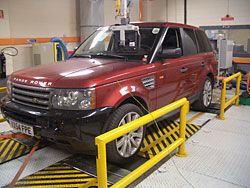 How can you force a vehicle built to operate in four-wheel drive to operate in two-wheel drive? Guidelines set by emissions certification agencies can require four-wheel drive vehicle manufacturers to answer this question. In many emissions testing procedures, the vehicle must run on a dynamometer, which requires two wheels to remain motionless while the remaining two drive wheels spin. For a vehicle that always runs in four-wheel drive, this mode of operation is impossible.
How can you force a vehicle built to operate in four-wheel drive to operate in two-wheel drive? Guidelines set by emissions certification agencies can require four-wheel drive vehicle manufacturers to answer this question. In many emissions testing procedures, the vehicle must run on a dynamometer, which requires two wheels to remain motionless while the remaining two drive wheels spin. For a vehicle that always runs in four-wheel drive, this mode of operation is impossible.
When faced with this problem for Land Rover vehicles, Jaguar and Land Rover used MathWorks tools and MICROGen target hardware from add2 Limited to emulate the controller for the transfer case in the transmission. This solution enabled Jaguar and Land Rover to operate the vehicle in two-wheel drive and achieve emissions certification from the Environmental Protection Agency (EPA) and other agencies without a problem.
Challenge
To test the vehicle on a two-wheel dynamometer, engineers removed one of the vehicle’s prop shafts. This change, however, caused problems in the vehicle’s control systems as they sensed two wheels spinning and two wheels motionless—a situation that typically occurs only during a real-world catastrophic failure. In particular, the vehicle’s transfer case controller is a fully electronic system that would not function properly in this mode of operation.
Because they were departing from the intended production specification, Jaguar and Land Rover needed to replace the transfer case controller to stop the control systems from entering a different operating mode and essentially destroying the clutch. They also needed to emulate the signals from the transfer case controller to the CAN bus so that the rest of the car believed the controller was still operating normally.
Jaguar and Land Rover initially considered contacting the transfer case controller manufacturer to create a one-off version of the controller. This costly approach would have required a minimum of 12 weeks, forcing Jaguar and Land Rover to postpone scheduled emissions tests.
Solution
A team of three engineers from add2, Jaguar, and Land Rover used Simulink?, Real-Time Workshop? Embedded Coder, and Target Support Package? FM5 to design, simulate, test, and implement a MICROGen-based system. With this system, Jaguar and Land Rover now operate Land Rover vehicles in two-wheel drive for emissions testing, saving weeks in development time.
The team used Simulink to create a high-level model of the transfer case controller, including input from and output to a CAN bus. They then ran simulations in Simulink to verify that all output signals were responding correctly to input events.
Using Real-Time Workshop Embedded Coder and Target Support Package FM5, the group then automatically generated code from their Simulink model and deployed it to the MICROGen target hardware, which is a generic target with integrated signal conditioning for rapid control prototyping, communications gateway, and smart data-logging applications. The engineers disconnected the vehicle’s original transfer case controller and installed the new MICROGen emulator for on-vehicle testing.
During testing, the engineers would note any faults that were raised by other control systems in the vehicle. They then used Simulink to modify the models, before regenerating the code and running additional tests. Updates to the MICROGen code were done in the vehicle, enabling some design iterations to be completed in fewer than ten minutes.
Once the team ran the car reliably in two-wheel drive, they conducted extensive tests to ensure no more faults occurred. The vehicle then underwent emissions certification testing.
Jaguar and Land Rover have since applied this approach for a number of certifying authorities and continue to expand its use on Land Rover models.
Results
Emissions certification achieved. MathWorks and add2 products enabled Jaguar and Land Rover to depart from the vehicle’s intended production specification. All vehicle systems see the valid CAN signals as expected. As a result, Jaguar and Land Rover can confidently present the emissions test results to certification authorities around the world. This approach has been used in successful certification tests for Japan and for the EPA in the U.S.
Development time cut by 75%. The transfer case controller manufacturer needed 12 weeks to produce a first version, which would likely require additional time to make it work properly. MathWorks tools and MICROGen enabled the team to complete the whole project in fewer than three weeks, enabling them to meet their scheduled test dates.
Reusable solution implemented. Jaguar and Land Rover can rapidly reuse their solution on new vehicles. The first system was developed for the Land Rover LR3, and has been subsequently applied in much less time to the Range Rover Sport and Range Rover. For their investment in a solution for one car, the team has three and potentially many more
(轉(zhuǎn)載)





